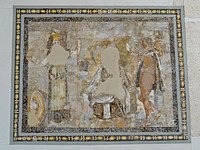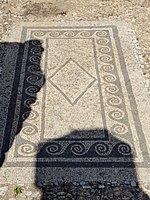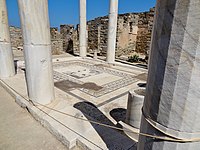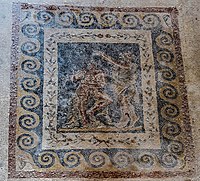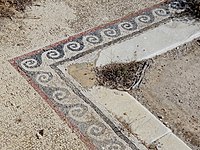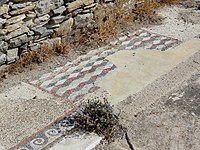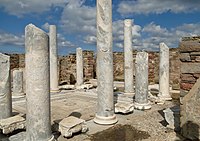Mosaics of Delos
The mosaics of Delos form a significant corpus of surviving ancient Greek mosaic art. Most of the surviving mosaic artworks from Delos, Greece, an Aegean island in the Cyclades, date to the last half of the 2nd century BC and early 1st century BC, during the Hellenistic period and beginnings of Roman Greece. Hellenistic mosaics were no longer produced after roughly 69 BC, due to warfare with the Kingdom of Pontus and subsequently abrupt decline of the island's population and position as a major trading center. Among Hellenistic-period archaeological sites, Delos contains one of the highest concentrations of surviving mosaic artworks as well as rare Greek wall paintings.
The paved walkways of Delos range from simple pebble or chip-pavement constructions to elaborate mosaic floors composed of tesserae. Most motifs contain simple geometric patterns, while only a handful utilize the opus tessellatum and opus vermiculatum techniques to create lucid, naturalistic, and richly-colored scenes and figures. Mosaics have been found in places of worship, public buildings, and private homes, the latter usually containing either an irregular-shaped floor plan or peristyle central courtyard.
Although there are minor traces of Punic-Phoenician and Romano-Italian influence, the Delian mosaics generally conform to the major trends found in Hellenistic art. The same wealthy patrons who commissioned paintings and sculptures at Delos may have also been involved in hiring mosaic artists from abroad. Delian mosaics share certain characteristics with mosaics in other parts of the Greek world, such as Macedonian mosaics in Pella. They also share some attributes with Greek painting traditions and often employ a similar black-background technique found in red-figure pottery of the Classical period.
Dating
Right: a Delian mosaic with pigeons flocking around a bowl, Archaeological Museum of Delos
Of the 354 mosaics of Delos studied by French archaeologist Philippe Bruneau,[2] only a handful were dated to the Classical period.[4] One mosaic was deemed to have been made in the Imperial Roman era.[4] The vast majority of mosaics, on the other hand, belong to the late Hellenistic period, contiguous with the late Roman Republic (i.e. the last half of the 2nd century BC and early 1st century BC).[5][4][6][2] Bruneau asserted that nominally undated pieces, judging by their styles, were produced within the same period as the main bulk of examples, dated roughly 133 to 88 BC.[4] In 167 or 166 BC, after the Roman victory in the Third Macedonian War, Rome ceded the island of Delos to the Athenians, who expelled most of the original inhabitants.[3] While the Roman destruction of Corinth in 146 BC allowed Delos to at least partially assume the former's role as the premier trading center of Greece, Delos' commercial prosperity, construction activity, and population waned significantly after the island was assaulted by the forces of Mithridates VI of Pontus in 88 and 69 BC, during the Mithridatic Wars with Rome.[7]
Characteristics
Composition
The composition of the Delos mosaics and pavements include simple pebble constructions, chip-pavement made of white marble, ceramic fragments, and pieces of tesserae.[4][8][2] The latter falls into two categories: the simpler, tessellated opus tessellatum using large pieces of tesserae, and the finer opus vermiculatum using pieces of tesserae smaller than four millimeters square.[4][9][2] Many Delian mosaics use a mixture of these materials, while chip pavement is the most ubiquitous, found in fifty-five homes and usually reserved for the ground floor.[10]

Arrangement and location
While some mosaics have been unearthed from religious sanctuaries and public buildings, most of them were found in residential buildings and private homes.[11] The majority of these houses possess an irregular-shaped floor plan, while the second largest group were built with a peristyle central courtyard.[12] Simple mosaics were usually relegated to normal walkways, whereas rooms designated for receiving guests featured more richly-decorated mosaics.[13][14] However, only twenty-five houses of Delos feature opus tessellatum mosaics and only eight houses possess the opus vermiculatum-style motifs and figured scenes.[4][9] The vast majority of decorated floors feature only simple geometric patterns.[4] It is also more common for opus vermiculatum and opus tessellatum mosaics to be found in upstairs rooms than on the ground floors of ancient Delian homes.[15] With the exception of the House of Dionysos and House of the Dolphins, the courtyards of peristyle homes in Delos feature only floral and geometric motifs.[14]

Patterns and motifs
Among the various patterns and motifs found in Delian mosaics is the triple-colored lozenge that creates a three-dimensional illusion of cubes in perspective for the viewer.[1][2] This pattern appears in fifteen different locations, making it one of the most common.[1] Other motifs include waves and stepped triangles, while major themes include maritime, theatrical, natural, or mythological objects and figures.[15] Rachel Hachlili writes that the single wave pattern, a common motif in Hellenistic art, is the most predominant type of border design for mosaics at Delos and appear in mosaics of Arsameia (albeit arranged in the opposite direction).[17] The rosette motif, which is found in the mosaics of various Hellenistic sites across the Mediterranean, is often coupled with single-wave borders in Delian mosaics.[16] The typical Hellenistic palmette motif is used in a mosaic of Delos to fill the four corners around a central rosette motif.[18]
Culture and ethnic origins
Aside from a sign of the Punic-Phoenician goddess Tanit, all pavement motifs are typically Hellenistic Greek in origin, although some pavement mortars used with tesserae designs betray some Italian influence.[6] Although the three major ethnic groups of Delos included Greeks (largely of Athenian origin), Syrians/Phoenicians, and Italians/Romans, it is very likely that many of these Italians were Italiotes, Greek-speaking natives of Magna Graecia in what is now southern Italy.[19] Delian inhabitants of either Greek, Italian, and Syrian origins owned mosaics in their private households, but Vincent J. Bruno asserts that the designs of their mosaic artworks were indebted entirely to Greek artistic traditions.[20]
Significance
The French archaeologist François Chamoux considered the mosaics of Delos as the "high-water mark" and pinnacle of ancient Greek mosaic art utilizing tesserae to create rich, detailed and colorful scenes.[5] This Hellenistic style of mosaic continued until the end of Antiquity and may have influenced the widespread use of mosaics in the Western world during the Middle Ages.[5] In her study of the households and artworks of Mediterranean trading centers, Birgit Tang analyzed three archaeological sites: Delos in the Aegean, Carthage in what is now modern Tunisia, and Emporion, modern Empúries in Catalonia, Spain, which was once a Greek colony.[21] The reasons for her choosing these sites in particular for investigation and comparison include their status as major maritime trading hubs as well as their relatively well-preserved ruins of urban households.[22]
Hariclia Brecoulaki asserts that the Delos mosaics represent the single largest collection of Greek mosaics.[2] She also states that only the Macedonian capital of Pella ranks as an equal in having private homes (as opposed to royal residences) decorated with elaborate wall paintings, signed mosaics, and freestanding marble sculptures.[23] Katherine M. D. Dunbabin writes that while many Hellenistic mosaics have been found in mainland Greece, Asia Minor, and northeast Africa (i.e. Cyrene), it is only at the site of Delos where they occur in "sufficient numbers to allow general conclusions about their use and nature."[4]
Houses and city quarters
Mosaics from the Northern Quarter
The Northern Quarter of Delos contains the Jewelry Quarter, [24] where older structures such as workshops and other archaeological remains dating to the 3rd century BC and early 2nd century BC have been discovered.[25] By the second half of the 2nd century BC these were replaced by private homes built in the most characteristic fashion for Delos: a narrow, rectangular floor plan with a central courtyard, a vestibule service room in the front, and a larger, main room in the rear. The quarter of the House of the Masks is the only area of Delos without this archetypal house plan.[26] Some houses of the Northern Quarter feature mosaic decorations with mythological scenes, including Lycurgus of Thrace and Ambrosia in an upper-story mosaic, as well as Athena and Hermes together with a seated woman in a main-room mosaic.[15]
-
Detail of a mosaic from the Jewelry Quarter of Delos depicting a bull's head with foilage
-
Detail of a mosaic from the Jewelry Quarter of Delos depicting an ancient Greek theatre mask
-
Detail of a mosaic from the Jewelry Quarter of Delos depicting an ancient Greek theatre mask
Mosaics from the Theatre Quarter
Like the House of the Lake, most houses in the crowded Theatre Quarter of Delos have irregular-shaped floor plans (such as trapezoidal designs), as opposed to square or rectangular designs.[27] Some of the houses in the Theatre Quarter lack interior decoration altogether, with neither wall murals nor mosaics, which is unusual for most Delian homes.[6]
House of Dionysos
The Delos mosaic of Dionysos riding a tiger in the House of Dionysos is one of the finest examples of opus vermiculatum, according to Dunbabin, and is comparable to the Dionysos riding a leopard from the House of the Masks if not the simpler pebble-mosaic predecessor from the Macedonian capital at Pella.[1] A key thematic difference, however, are the wings of Dionysos that suggest his incarnation as a daimon instead of a god.[28][2] The tesserae materials, made of glass, faience, terracotta and natural stones, are fashioned into pieces measuring roughly one millimeter square, allowing for sharp detail and an elaborate color scheme.[28][2]
-
Dionysos riding a tiger
-
Dionysos riding a tiger
-
Detail of a Hellenistic glass vessel from the mosaic of Dionysos riding a tiger
-
Floor mosaic in the peristyle hall of the House of Dionysos
House of the Masks
The House of the Masks is named after the mosaic motif of theatre masks decorating ivy scrolls arranged in strips around a central surface area decorated in a cubic pattern.[29] The more intricately decorated mosaics are found in four different rooms branching off from the peristyle courtyard paved with marble chips, with corridor mosaics utilizing amphora fragments.[30] In the center of one mosaic is the figure of Dionysos riding a leopard against a similar black background to the mosaic in the House of Dionysos.[29] Another central mosaic features a flute player and a dancing figure, the latter perhaps representing Silenus.[29] Only the Dionysos figure employs the vermiculatum method. The other mosaics of the house fail to achieve the naturalism of finer figure scenes and motifs, but they nevertheless demonstrate an attempt at mimicking their illusionist qualities with the tesselated technique.[29]
-
Dionysos riding on a feline creature
-
A silk-clad figure dancing to the tune of a flute player
-
Mosaic of a theatre mask
House of the Lake
Similar to the design of the majority of Delian homes,[27] the House of the Lake is an irregular-shaped home (as opposed to a rectangular or square floor plan), located near a sacred lake and inhabited from roughly 300 to 100 BC. The peristyle impluvium is decorated with a geometric-patterned motif around a central rosette, surrounded on all sides by monolithic columns in the Ionic style.[31]
-
An example of the single-wave-patterned border
-
Cube-pattern mosaic with the single-wave border
House of the Dolphins
The House of the Dolphins contains a peristyle floor mosaic design that is unusual for Delos, with a circle enclosed by a square outline.[32] In each corner of the square are pairs of dolphins ridden by tiny winged figures bearing the emblems of various Greek deities, namely the thyrsus, caduceus, trident, and one object that is missing due to damage.[32] The circle contains a central rosette design surrounded by floral garlands and griffins. The mosaic, signed by a certain Asklepiades of Arados (in ancient Phoenicia, now western Syria), is one of only two examples from Delos that bear a signature of the original artist.[32]
-
Dolphins and riders next to bands of single-wave-pattern motifs
House of the Trident
The House of the Trident contains peristyle panels with the motif of a black dolphin situated around a red anchor and black tridents against a white background. The theme suggests that the owners of the house were somehow connected to maritime pursuits.[33] These simple, two-dimensional mosaics stand in contrast to the multicolored, finely-detailed, three-dimensional Hellenistic mosaics of figures and motifs.[29] They are perhaps comparable or even linked to the black-and-white pavement mosaics that appear in Roman Italy some decades later.[29]
Connections to other mediums of ancient Greek art
Red-figure pottery was no longer produced by the time the Delos mosaics were made. However, the black background technique of red-figure pottery was still appreciated in not only 4th-century-BC Macedonian pebble mosaics from Pella, but also mosaics at Delos, such as the white-figured tritoness mosaic with tesserae.[34] The black background technique was later used in glass art such as cameo glass, particularly Roman glass (e.g. Portland Vase, Gemma Augustea, Great Cameo of France, etc.).[34]
The undulating garland motif against a black background found in the masonry-style mural paintings at Delos were also featured in earlier Greek works of art ranging from vases to 4th-century-BC Macedonian mosaics of Pella, particularly the Stag Hunt Mosaic.[35] However, the painters of Delos arguably invented their own decorative genre using a combination of these older elements with new naturalistic coloring.[35] Aside from the black background, mosaics like the Stag Hunt Mosaic were also inspired by the illusionist, three-dimensional qualities of Greek paintings.[36] At Delos, paintings and mosaics inherited the same Classical Greek standards of craftsmanship, lighting, shading, and coloring.[20] Sculptors, painters, and mosaic artists may have all been part of the same system of patronage at Delos, which in some instances would have necessitated the importation of foreign artists.[37]
See also
Notes
- ^ a b c d Dunbabin (1999), p. 32.
- ^ a b c d e f g h i Brecoulaki (2016), p. 678.
- ^ a b Tang (2005), p. 14.
- ^ a b c d e f g h i Dunbabin (1999), p. 30.
- ^ a b c Chamoux (2002), p. 375.
- ^ a b c Tang (2005), p. 48.
- ^ Tang (2005), pp. 14, 32.
- ^ Tang (2005), pp. 45, 47.
- ^ a b Tang (2005), p. 45.
- ^ Tang (2005), p. 47.
- ^ Dunbabin (1999), pp. 30–32.
- ^ Tang (2005), p. 40.
- ^ Dunbabin (1999), pp. 30–32, 306.
- ^ a b Tang (2005), pp. 46–47.
- ^ a b c Tang (2005), p. 46.
- ^ a b Hachlili (2009), pp. 9–10.
- ^ Hachlili (2009), p. 10.
- ^ Hachlili (2009), p. 11.
- ^ Tang (2005), pp. 14–15.
- ^ a b Bruno (1985), pp. 13–14.
- ^ Tang (2005), pp. 13–18.
- ^ Tang (2005), pp. 13–14.
- ^ Brecoulaki (2016), pp. 673, 678.
- ^ Or in French: Îlot des bijoux.
- ^ Tang (2005), p. 32.
- ^ Tang (2005), pp. 40–41.
- ^ a b Tang (2005), p. 33.
- ^ a b Dunbabin (1999), pp. 32–33.
- ^ a b c d e f Dunbabin (1999), p. 35.
- ^ Dunbabin (1999), pp. 33–35.
- ^ Crane, "Delos, House of the Lake (Building)", accessed 17 July 2017.
- ^ a b c Dunbabin (1999), p. 33.
- ^ Dunbabin (1999), pp. 35, 306.
- ^ a b Bruno (1985), p. 31.
- ^ a b Bruno (1985), p. 21.
- ^ Hardiman (2010), p. 518.
- ^ Bruno (1985), pp. 12–13.
References
- Brecoulaki, Hariclia (2016), "Greek Interior Decoration: Materials and Technology in the Art of Cosmesis and Display", in Irby, Georgia L. (ed.), A Companion to Science, Technology, and Medicine in Ancient Greece and Rome, Blackwell Companions to the Ancient World, vol. 1, Oxford: Wiley-Blackwell, pp. 672–692, ISBN 9781118372678.
- Bruno, Vincent, J. (1985), Hellenistic Painting Techniques: The Evidence of the Delos Fragments, Columbia Studies in the Classical Tradition, vol. 11, Leiden: E. J. Brill, ISBN 9004071598.
{{citation}}: CS1 maint: multiple names: authors list (link) - Chamoux, Françios (2002) [1981], Hellenistic Civilization, translated by Michel Roussel, Oxford: Blackwell, ISBN 0631222421.
- Crane, Gregory R. "Delos, House of the Lake (Building)". Perseus Digital Library, Tufts University. Accessed 17 July 2017.
- Dunbabin, Katherine, M. D. (1999), Mosaics of the Greek and Roman World, Cambridge: Cambridge University Press, ISBN 0521002303.
{{citation}}: CS1 maint: multiple names: authors list (link) - Hachlili, Rachel (2009), Ancient Mosaic Pavements: Themes, Issues, and Trends: Selected Studies, Leiden: E. J. Brill, ISBN 9789004167544.
- Hardiman, Craig I. (2010), "Classical Art to 221 BC", in Roisman, Joseph; Worthington, Ian (eds.), A Companion to Ancient Macedonia, Oxford: Wiley-Blackwell, pp. 505–521, ISBN 9781405179362.
- Tang, Birgit (2005), Delos, Carthage, Ampurias: the Housing of Three Mediterranean Trading Centres, Rome: L'Erma di Bretschneider (Accademia di Danimarca), ISBN 8882653056.





